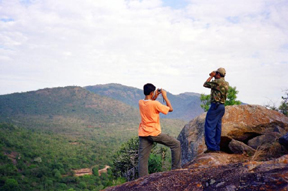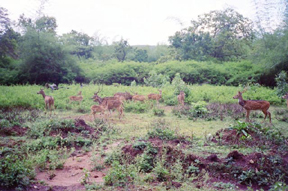Inside the Woodlands of Wodeyars
Part II
-Saraswati Kavula
The night began with the screening of a film about a leopard cub brought up by
a conservationist. The story was fascinating, for after having left the farm as
an adult, the leopard came to her ‘foster fathers’ home, to deliver her babies;
the way women would go to their paternal home in India. This brought to mind the
recent controversy about Tiger Farms, while what the man in the film did was out
of compassion for a cub orphaned by poachers; who ultimately trained the leopard
to live in the wild, can the Tiger farms create the same quality of wildlife the
way we see in nature? Asides to all the other connotations, I would really not
like to see a Tiger in captivity, they look sad and unhealthy, the way the
animals in the Zoo look like. Why tigers, even poultry animals grown in the
farms look miserable and are more diseased as compared to the “free living
native chicken’.
On the safari we met other residents of the lodge – most of them were from
Bangalore, and none of them looked like they could take some rough treatment.
One gentleman, Purshottam, who worked for Hewlett Packard, asked us, if we drove
down from Bangalore, “No, we came in the bus”, I replied. “Tough Cookies, ah!”
was his remark. I wonder what would happen if they had to go camping the way we
did in Kawal Wild Life sanctuary, staying in a tribal village, hiring out cots
from the adivasis for Rs.20, eating food from the village, using the public
buses to reach the sanctuary, walking at least a dozen kilometers a day. “We
spent just Rs. 600 for the whole trip”, I described the trip to another lady in
the group, who was an ex-journalist in the Gujarati media. “Perhaps that is the
best way to do it, in harmony with nature”, she remarked. As far the others,
they would think I was crazy.

The campfire extended into a bar with a choice of drinks and liquor available
for the lodgers. “This is what I hate in this place, it doesn’t seem like a
campfire at all”, said Meera, a scientist from Bangalore. “And I am really not
too glad about the new cottages that they are building with the swimming pool
and massage centre”. “Are you going to have air-conditioning also?”, I asked
Gangaswamy the next day morning. “No, no, we are using the insulation mechanisms
to keep the rooms cool, the way we did with the present construction.” “What is
the need for a swimming pool or a massage centre, when people come here to spend
time in the wild?” “Can’t help it madam, a lot of tourists are asking for such
things. Even the other resorts like Tusker Trails and Country Club are offering
these facilities, so, we must keep up with the competition. That is why the
management has decided to go ahead with the additional facilities”. I began to
wonder what will be the place like after such an expansion. And what will happen if
in the name of promoting wildlife tourism, there are many more such expansions and
newer resorts coming up in the area? A lot more construction was already on, in the
area opposite to the road. ‘This must be another resort coming up”, I remarked as
we went past the place the next day morning on our trek to the nearby mountain.
“Well that is
sad. Soon this place will change!” remarked Purshottam. I suppose we all want
our luxury even when we wish to go away from the city life, and also want it to
be exclusive.
In our post dinner conversation the day before he was mentioning, about their
trip near Rishikesh, “It is a fabulous place, twenty kilometers above Rishikesh,
the Ganga is so fresh and white. The moment the river comes down to Rishikesh
and Haridwar it gets muddy. The place where we stayed was superb; it was just
on the edge of the mountain, overlooking the Ganga, called, “Glass House on the
Ganges”, first class facilities. Just lovely, we went rafting there”. It is a
different story that mushrooming hotels in the area have dirtied Rishikesh and
Haridwar.
On the second day there were eight of us, who opted for the early morning
trek. Most others went on the Safari. The view was fantastic and we even got to
see a herd of eleven elephants with their babies. And as bonus, close to the
lodge, we saw a herd of nearly 60-70 spotted deer. As we climbed down, Nataraj
our guide stopped to check out the lone Tree in that area. “I saw a leopard just
yesterday in this tree. Just checking to see, if he is still there,” of course,
he had already left his perch.
